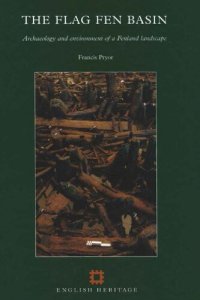
Ebook: The Flag Fen Basin: Archaeology and Environment of a Fenland Landscape
Author: Francis Pryor
- Genre: History // Archaeology
- Series: English Heritage Archaeological Reports
- Year: 2001
- Publisher: English Heritage
- City: Swindon
- Language: English
- pdf
With major contributions by J. C. Barrett, S. D. Bridgeford, D. G. Buckley, D. G. Coombs, C. Evans, C. A. I. French, P. Halstead, J. Neve, J. P. Northover, M. Robinson, R. G. Scaife, and M. Taylor, and principal illustrations by J. Coombs, D. Hopkins, and C. J. Irons.
Ebook (PDF) published 2012.
The Flag Fen Basin has been the subject of nearly continuous archaeological research since about 1900. Most of the archaeological research described in this book took place in response to building development during the past 30 years. Between 1971 and 1978 the Fengate Project revealed two Bronze Age ditched field systems laid out for the management of large numbers of livestock. At the centre of one field system, a complex pattern of droveways, yards, and paddocks has been interpreted as a communal 'marketplace' for livestock exchange and regular social gatherings. A major droveway linked this area to an enigmatic wooden platform and to a post alignment, which runs for more than a kilometre across the wetland. While there is no doubt that these structures were a route across wet ground, it is still not fully understood why the Bronze Age people who built them deposited 'offerings' of spears, daggers, swords, and jewellery into the associated lake. Nevertheless, it is believed that religious rituals were involved. The excellent conditions of preservation have enabled the excavators to undertake detailed examinations of the woodworking and associated archaeological remains, and to discuss the nature of the remains, their ritual significance, and the possible social implications. The report also includes a detailed summary of recent commercial excavations at Fengate. In particular, this research sheds new light on the Neolithic landscape, on the Iron Age and Roman landscapes, and on the changing environmental conditions since the earlier Neolithic.
Ebook (PDF) published 2012.
The Flag Fen Basin has been the subject of nearly continuous archaeological research since about 1900. Most of the archaeological research described in this book took place in response to building development during the past 30 years. Between 1971 and 1978 the Fengate Project revealed two Bronze Age ditched field systems laid out for the management of large numbers of livestock. At the centre of one field system, a complex pattern of droveways, yards, and paddocks has been interpreted as a communal 'marketplace' for livestock exchange and regular social gatherings. A major droveway linked this area to an enigmatic wooden platform and to a post alignment, which runs for more than a kilometre across the wetland. While there is no doubt that these structures were a route across wet ground, it is still not fully understood why the Bronze Age people who built them deposited 'offerings' of spears, daggers, swords, and jewellery into the associated lake. Nevertheless, it is believed that religious rituals were involved. The excellent conditions of preservation have enabled the excavators to undertake detailed examinations of the woodworking and associated archaeological remains, and to discuss the nature of the remains, their ritual significance, and the possible social implications. The report also includes a detailed summary of recent commercial excavations at Fengate. In particular, this research sheds new light on the Neolithic landscape, on the Iron Age and Roman landscapes, and on the changing environmental conditions since the earlier Neolithic.
Download the book The Flag Fen Basin: Archaeology and Environment of a Fenland Landscape for free or read online
Continue reading on any device:

Last viewed books
Related books
{related-news}
Comments (0)